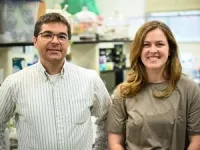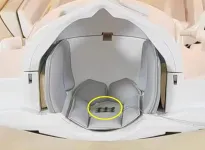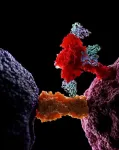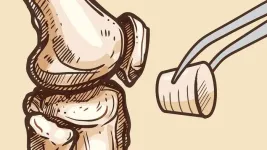(Press-News.org) UNIVERSITY PARK, Pa. — Burrowed into streambeds and rarely moving for their decades-long lifespans, freshwater mussels are biomonitors, meaning they indicate how clean their environment is, according to Penn State researchers. As the bivalves feed on organic matter and filter the water around them, their inner tissues and hard shells begin to reflect whatever is in their environment — including radioactive particles.
A pair of researchers from Penn State’s Department of Civil and Environment Engineering (CEE) analyzed the composition of mussels downstream of a centralized treatment facility in Western Pennsylvania that had accepted and treated fracking wastewater from the oil and gas industry for at least two decades. The now-decommissioned facility stopped accepting oil- and gas-produced wastewater in 2019.
The researchers found that, even years later, the tissue and shells of mussels contained radium that could be traced to wastewater from fracking in the Marcellus Shale. The rock formation stretches underground from West Virginia through New York and is the largest natural gas field in the country. Their findings are available online now and will appear in the June issue of Science of the Total Environment.
Though most facilities in Pennsylvania do not accept oil- and gas-produced water now, from 2008 to 2011, Pennsylvania’s rivers and streams saw a significant volume of treated wastewater that originated from fracking in the Marcellus Shale. Wastewater treatment facilities remove major contaminants, including radium, before discharging the water into surface water, like rivers, according to researchers. However, the treated water still contains trace amounts of contaminants and is five to 10 times saltier than ocean water.
“With a much higher salinity than the surrounding environment, the discharged water has a different chemical fingerprint than what the mussels are used to,” said Nathaniel Warner, professor of CEE and corresponding author on the paper. “Mussels that were closest to the water discharges died off. Further downstream, the mussels found a way to tolerate the salinity and radioactive materials and instead absorbed them into their shells and tissues.”
He explained that other types of wastewater generally do not contain many radioactive particles, but oil and gas wastewaters found deep in the earth and brought out by fracking often contain specific unique element ratios — a kind of signature that can be traced. The unique ratios of radioactive elements allowed the team to identify that the source of the contaminants is likely the treated Marcellus Shale wastewater.
To collect the samples for radium analysis, Katharina Pankratz, a doctoral candidate in CEE and first author on the paper, contacted the Pennsylvania Department of Environmental Protection (DEP) to get a permit to sample mussels in the Allegheny River. DEP biologists, who offered to help with collection, identified the species that were present, then randomly collected 10 eastern spikes — a common type of mussel — from four designated locations along the river.
The researchers found that half a kilometer downstream of a discharge site, mussels had approximately double the total radium levels as those upstream of the discharge site. And mussels five kilometers downstream of a discharge site had less than the mussels closer to the site, but still had a measurable amount of radium.
Radiation exposure is measured in dose units known as micro-Seiverts (μSv). The researchers compared the radioactivity of the sampled eastern spikes to Brazil nuts, which take up radiation from the soil in which they grow. A 28-gram serving of Brazil nuts contain 0.47 to 0.80 μSv, while the maximum value calculated for a single mussel collected by researchers in the study was 63.42 μSv. The International Atomic Energy Agency recommends that individuals limit their annual exposure to no more than 1,000 μSv. Any more exposure can lead to health problems.
“Along with nutrients, mussels also filter contaminants present in the water column, like metals, microplastics, synthetic chemical compounds and other emerging contaminants of concern,” Pankratz said. “Depending on the contaminant and its chemistry, if it is small enough to pass through the gills of the mussel, it has the potential to accumulate in their tissue or precipitate within the hard-shell structure.”
While these mussels are not harvested for human consumption, larger species, like waterbirds, raccoons, muskrats and otters, regularly eat freshwater mussels, meaning the contamination could pass up the food chain, Pankratz said.
“It raises concerns about potential impacts on other aquatic life, particularly endangered species more vulnerable to contaminants,” she said. “This information may help shape future regulations for wastewater disposal to surface water, especially in regions where mussels are harvested for food. I hope this study will inspire further research into the ecological consequences of these disposals worldwide.”
The U.S. National Science Foundation supported this work.
END
Mussels downstream of wastewater treatment plant contain radium, study reports
2024-05-31
ELSE PRESS RELEASES FROM THIS DATE:
This self-powered sensor could make MRIs more efficient
2024-05-31
MRI scans are commonly used to diagnose a variety of conditions, anything from liver disease to brain tumors. But, as anyone who has been through one knows, patients must remain completely still to avoid blurring the images and requiring a new scan. A prototype device described in ACS Sensors could change that. The self-powered sensor detects movement and shuts down an MRI scan in real time, improving the process for patients and technicians.
During an MRI scan, a patient must stay entirely still for several minutes at a time, otherwise “motion artifacts” could appear and blur the final image. To ensure a clear picture, patient movement needs to be identified as ...
Cognitive declines preceding Alzheimer’s diagnosis lead to credit card, mortgage delinquency
2024-05-31
(May 31, 2024) — In the years prior to an Alzheimer’s disease or other memory disorder diagnosis, credit scores begin to weaken and payment delinquency begins to increase, concludes new research led by Georgetown University. The findings show consistent deterioration in these financial outcomes over the quarters leading up to diagnosis. The findings also show that credit card and mortgage delinquencies, specifically, both increase substantially prior to diagnosis.
The research was released today by the Federal Reserve Bank of New York (FRBNY). (“The Financial Consequences of Undiagnosed Memory Disorders”).
“Most memory disorders ...
Eye-tracking techniques could help primary care providers diagnose autism sooner, more accurately
2024-05-31
INDIANAPOLIS — Nearly 3% of all children in the United States are diagnosed with autism, according to the Centers for Disease Control and Prevention. But a collaborative team of researchers at Indiana University and Purdue University are finding ways to make the right diagnosis sooner.
“The number of children needing autism evaluations exceeds the capacity of specialists trained to provide this service,” said Rebecca McNally Keehn, PhD, assistant professor of pediatrics at the IU School of Medicine. “Children and their families are currently waiting a year or more to access evaluations. ...
Antibodies may aid effort to fight influenza B: Study
2024-05-31
Researchers at Vanderbilt University Medical Center have isolated human monoclonal antibodies against influenza B, a significant public health threat that disproportionately affects children, the elderly and other immunocompromised individuals.
Seasonal flu vaccines cover influenza B and the more common influenza A but do not stimulate the broadest possible range of immune responses against both viruses. In addition, people whose immune systems have been weakened by age or illness may not respond effectively to the flu shot.
Small-molecule drugs that block neuraminidase, a major surface glycoprotein of the ...
ASCO: Novel CAR T therapy and shorter targeted therapy durations show promise for patients with leukemia
2024-05-31
Novel CAR T cell therapy obe-cel yields strong remission rates in adults with relapsed or refractory B-ALL (Abstract 6504)
The novel anti-CD19 autologous chimeric antigen receptor (CAR) T cell therapy obecabtagene autoleucel (obe-cel) achieved durable remissions in 40% of patients with relapsed or refractory B-ALL without a subsequent stem cell transplant (SCT), according to results from the Phase Ib/II FELIX clinical trial presented today by Elias Jabbour, M.D., professor of Leukemia.
At a median follow-up of 21.5 months, these patients were in ongoing remission ...
Synthetic plugs offer alternative to total knee replacements
2024-05-31
Osteochondral defects (OCDs) can cause damage to cartilage and underlying bone, leading to chronic pain and loss of joint function. Depending on the extent of damage, individuals must undergo surgical treatment, the most extensive being total knee replacement, which over 800,000 Americans undergo each year.
Dr. Melissa Grunlan, professor in the Department of Biomedical Engineering at Texas A&M University, received a grant from the National Institute of Arthritis and Musculoskeletal and Skin Disease, a suborganization of the National Institutes ...
CU researchers analyze prevalence, impact of ethical or religious barriers to providing medical aid in dying
2024-05-31
Recently published research led by the University of Colorado Anschutz Medical Campus examined the prevalence — and impact — of physicians’ ethical or religious barriers to their involvement in medical aid in dying (MAiD), a multi-step process where a physician provides a terminally ill adult with decision-making capacity with a lethal dose of medication to end their life.
The research article, “Conscience-Based Barriers to Medical Aid in Dying: A Survey of Colorado Physicians,” was published this May in the Journal of General Internal Medicine. It shows that 26% of physician ...
Want to be a successful scientist? The McClements family has some tips
2024-05-31
The latest book of prolific author David Julian McClements is a family affair. The Distinguished Professor of Food Science, along with his daughter Isobelle Farrell McClements and nephew Jake McClements, have written “How to be a Successful Scientist: A Guide for Graduate Students, Postdocs, and Professors” (Springer, 2024).
The three authors offer different perspectives as scientists at different stages in their careers. Julian McClements, who has published more than 1,300 scientific articles and numerous books, is the most highly ...
Overcoming barriers to heat pump adoption in cold climates and avoiding the 'energy poverty trap'
2024-05-31
Converting home heating systems from natural gas furnaces to electric heat pumps is seen as a way to address climate change by reducing greenhouse gas emissions.
But a new University of Michigan study of 51 Southeast Michigan households shows that switching to efficient, cold-climate heat pumps would increase annual utility bills by an average of about $1,100.
Home weatherization upgrades, such as adding attic insulation and sealing around doors and windows, could help reduce utility bills and make ...
A new way to see viruses in action
2024-05-31
A new, nano-scale look at how the SARS-CoV-2 virus replicates in cells may offer greater precision in drug development, a Stanford University team reports in Nature Communications. Using advanced microscopy techniques, the researchers produced what might be some of the most crisp images available of the virus’s RNA and replication structures, which they witnessed form spherical shapes around the nucleus of the infected cell.
“We have not seen COVID infecting cells at this high resolution and known what we are looking at before,” said Stanley Qi, ...





